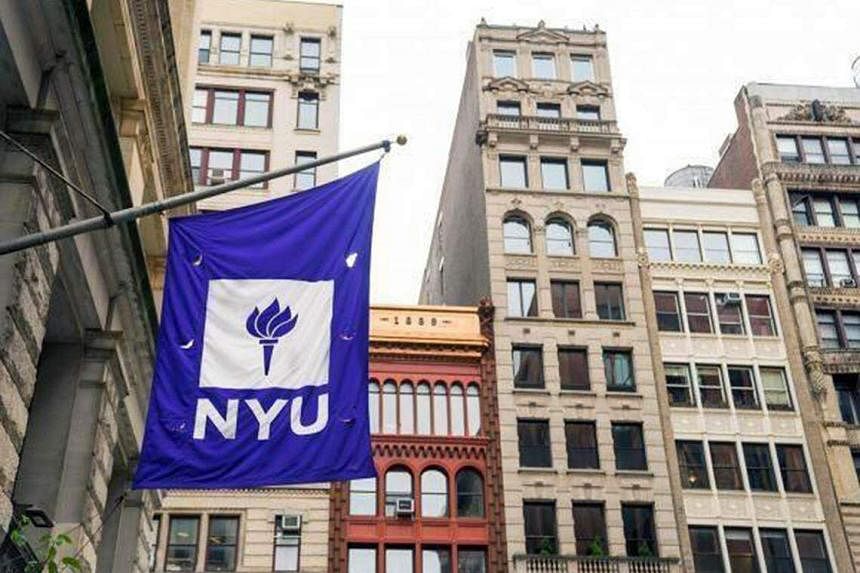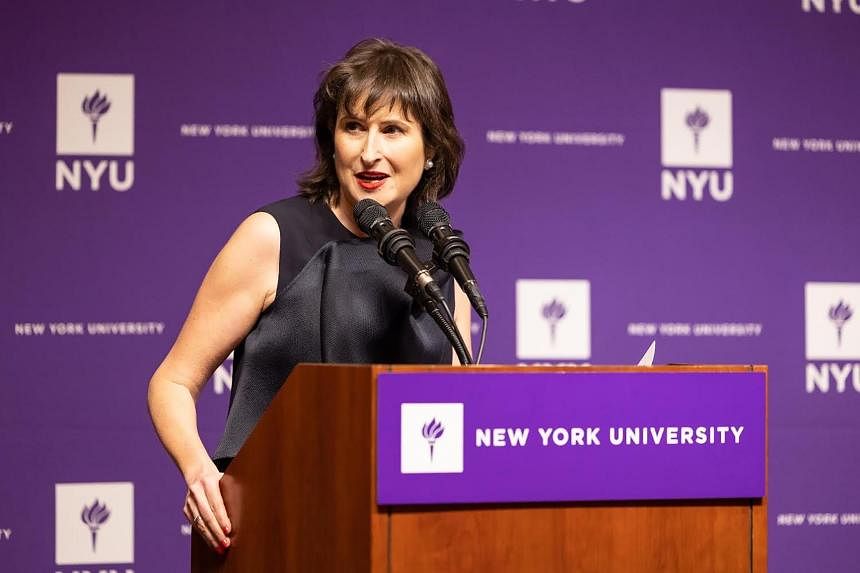What do actors Timothee Chalamet and Rooney Mara, model Christy Turlington, violinist Midori, Instagram chief executive Adam Mosseri and online marketplace Etsy’s co-founder Robert Kalin have in common?
Apart from appearing on who’s who lists of famous people, they all attended the New York University Gallatin School of Individualised Study, renowned among liberal arts colleges in the United States for allowing its students to design their own interdisciplinary degrees that meet their specific interests and career goals.
The school’s dean, Professor Victoria Rosner, is heartened to hear that the dons at Singapore Management University (SMU) studied the Gallatin model when planning its new College of Integrative Studies (CIS).
CIS, which will open in 2023, will allow students to pick from about 1,000 courses offered by the various schools in SMU.
In an interview with The Straits Times, Prof Rosner, herself an interdisciplinary scholar, said the flexibility given to Gallatin students to choose their own majors has resulted in some unusual degree combinations and majors.
They include mathematics and economics for international development, multimedia storytelling and computer science, public policy and colonial theory, the neuroscience of art and commoditisation of art, and happiness studies, to name a few.
However unusual the majors may be, Prof Rosner noted that the education at Gallatin has enabled students to access a range of jobs in the new economy. It has also allowed many to create their own “bespoke” careers.
More recently, many students have chosen to focus their majors on sustainability issues and gone on to become leaders in environmental action and awareness.
Q: It is unusual for universities to offer an individualised study programme, and it is often hard to find the right faculty for such an endeavour. Yet, Gallatin has been offering it for decades now. How exactly does it work?
A: In the first two years, Gallatin students are introduced to interdisciplinary learning and encouraged to explore a variety of courses, required and elective, both within and outside of Gallatin. They also have opportunities to get involved in the world beyond school through internships, cultural events, study-away programmes, and much more.
In addition to their Gallatin courses, every semester, students have thousands of courses to choose from across New York University, many taught by some of the country’s leading research scholars and teachers.
In their second year, students work with their advisers to develop their Gallatin concentration, a unique interdisciplinary programme of study, organised around a theme, a problem, or a set of related ideas they want to delve into. It could be the economics of international development, or multimedia storytelling, or neuroscience and art. They learn to take initiative, to solve problems, and to think critically about their world.
The Gallatin concentration culminates in each student’s colloquium, a conversation with faculty where students reflect on their concentration in relation to a list of works and synthesise their experiences. It is a great moment.
Q: Why does NYU believe it is important to offer students an individualised study programme?
A: During their time with us, we want to help our students figure out what is important to them. What motivates them? Who do they want to become? Figuring out what they want to study is a very good way of guiding students to reflect on these questions.
Q: But is this not difficult for a young person to do at 19?
A: At Gallatin, we find that developing the concentration is a uniquely empowering experience for our students. This is true both for students who are not sure of their interests at the outset and those who have specific interests that do not match up with traditional majors.
It is a challenge, yes. But that is why our students have lots of help – dedicated advisers who serve as mentors to guide them as they find their way.
The advisers work with the students to ensure that the concentration a student chooses has depth, breadth, rigour and coherence, and that it will help them access and succeed in the kind of careers they want to pursue. Advisers also help the students reflect on their goals, their identities and other aspects of college life.
Q: Why the intense focus on interdisciplinary studies, from their first year right through to their choice of major, which has to be based on a theme that crosses disciplinary boundaries?
A: Interdisciplinarity is now acknowledged to be a very potent idea in higher education. But it is by no means new. It has been around since at least the 1930s and continues to gain momentum. Universities were built to foster single-discipline, in-depth knowledge and specialised studies. But that structure is changing as we recognise that the complexities of current world problems go beyond the capability of any single discipline.
The global issues we are faced with are complex and interconnected, and our understanding and approaches can be limited by individual disciplines operating in silos.
The recent Covid-19 pandemic is a good example. Although Covid-19 is a disease, the pandemic is not just a medical issue. It is also a problem that requires a coordinated response that spans many fields: public health, communication, epidemiology, the arts, and more. We need an approach that integrates knowledge, skills and insights from a range of areas.
Or take another big challenge: climate change. It is another place where we need to embrace interdisciplinary approaches – integrating knowledge from climate sciences, social sciences, engineering, humanities, arts, business and more.
Interdisciplinary learning leads students to be agile thinkers, adaptable and effective problem-solvers. Critical thinking skills develop as students look across disciplinary boundaries to consider other viewpoints and begin to compare and contrast concepts across subject areas.
Students begin to consolidate learning by synthesising ideas and considering alternative ways of approaching issues. It sounds complicated but it actually unfolds very naturally.
From the career paths of our students, we can see that employers value the skills acquired through this kind of learning. Most careers require individuals to work with teams formed by specialists in different fields. You need to consider different approaches and perspectives to solve problems.
The critical thinking and problem-solving skills developed by interdisciplinary education, along with the collaborative mindset and confidence gained from experiential learning, give our graduates many advantages in the workplace.

Q: You mentioned sustainability issues. As you know, your students who belong to Generation Z show the most concern for the planet’s well-being. As a result, there is demand for what they call green academics. How is Gallatin catering to their interests and concerns in this field?
A: Students at Gallatin are leaders in environmental studies, action and awareness. Gallatin students were the first to create a sustainability task force at NYU and their efforts resulted in a Leed (Leadership in Energy and Environmental Design) Gold-certified building for Gallatin.
For a time, a Gallatin alumnus, Mr Jeremy Friedman, led NYU’s first Office of Sustainability – the group that created our campus cogeneration power plant, planted green roofs on academic buildings and developed innovative and effective recycling, composting, and bike-sharing programmes for the entire New York City academic hub. Jeremy’s Gallatin concentration was environmental values and public policy.
The ability of students to chart their own courses of study and the variety of faculty who support this have led to an explosion of green courses, concentrations and projects at Gallatin.
Recent Gallatin courses focusing on sustainability include Good Design: Scale; A Sense of Place; Mapping as a Spatial, Political and Environmental Practice; Ecology and Environmental Thought; Green Design from Geddes to Gore; History of Environmental Sciences Before Darwin; and Trash Matters: Exploring Development, Environment and Culture through Garbage.
We also run symposia and offer grants for projects that students want to undertake. We have a dedicated fund, the Horn Family Environmental Studies Resource Fund, to support sustainability and educational programmes and projects surrounding it. And we have a new art/science site on New York City’s Governors Island, the Gallatin WetLab, where students work on the New York City coastline.
As I said before, interdisciplinary research and teaching is uniquely suited to the study of sustainability.
Not limited by fields, departments or majors, our students can create concentrations that explore green issues from every angle, and our faculty bring an impressive breadth of knowledge from various fields.
About Victoria Rosner
Professor Victoria Rosner took over as dean of the Gallatin School of Individualised Study last July. Prior to that, she served as dean of academic affairs at Columbia University’s School of General Studies. She began her academic career in 1988 as an assistant professor at Texas A&M University.
Her own scholarship focuses primarily on literary modernism seen from an interdisciplinary perspective, and her books illuminate the complex ways in which literature shares a conceptual lexicon with architecture, design, science and technology.
She has received awards and honours from organisations including the Graham Foundation, the Modernist Studies Association and the National Endowment for the Arts.
Prof Rosner is the author of Machines For Living: Modernism And Domestic Life, as well as Modernism And The Architecture Of Private Life. She is also editor of The Cambridge Companion To The Bloomsbury Group and The Global And The Intimate: Feminism In Our Time.
She is co-editor of Gender And Culture at Columbia University Press, the pre-eminent book series on gender and the humanities.
A native New Yorker, Prof Rosner received her Bachelor of Arts and Master of Arts degrees and PhD in English and comparative literature from Columbia University.
The event is free to attend and registration will close at 6pm on March 8. To register, click here.



